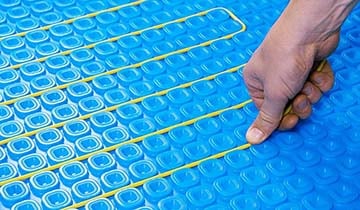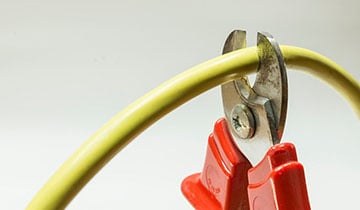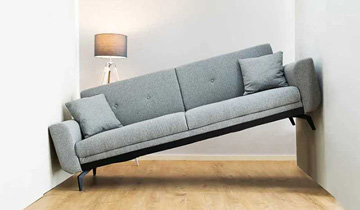6 min read
How much underfloor heating do I need and how much does it cost?
Probably if you’ve ended up at this blog, you’ve already decided to use electric underfloor heating in your project.

When it comes to building or even renovating, you only want to do it once, or it becomes a very costly exercise. And while most homeowners like to focus on the colours, design and even their gardens, one of the major considerations is electric underfloor heating.
Why? Well, the space saving and energy efficiency gains that result from using electric underfloor heating over conventional radiators is the first benefit that springs to mind. However, lesser-known scientific reasons behind the popularity of electric underfloor heating and how this heating method ties in closely with the design of the human body should also be mentioned. Yes, you read correctly, electric underfloor heating has been deliberately designed for human comfort!
Did you know. Humans are most comfortable when the head is 2 to 3 degrees cooler than the rest of the body? This is why the human body warms from the feet upwards, keeping the head as cool as possible. So, there really is no better heating system for a home than electric underfloor heating that radiates gentle heat from the floor up!
While the benefits of electric underfloor heating are easy to realise, installing an electric underfloor heating system correctly is critical. Failing to carry out the installation correctly can reduce system performance, eventually causing the heating cable or thermostat to fail completely. By understanding where mistakes are likely to occur, installers and homeowners can be sure to limit the risk of costly errors.

1. Plan, plan, plan!
Honestly, you can never over plan an electric underfloor heating installation. It is best to have all of your requirements outlined before starting. This helps to minimise the likelihood of errors or the need to redo projects. Key considerations are: desired output, floor substrate, insulation, thermostat position, floor sensor position, floor finish, maximum temperatures, programmable thermostat or smart thermostat?
2. Make sure the electrical circuit is suitable
One of the top considerations with any electric heating system is the total load (current in Amps) that the heater requires to operate. An electric underfloor heating system uses a considerable amount of current so be sure to check the total load of the electric underfloor heating does not exceed the total load capacity of the electrical circuit.
For example, a 10A electric underfloor heating system should be connected to the mains supply via a 16A thermostat and a 13A fused spur. Also, the power supply should be protected by a 30mA RCD and there should be capacity for the extra load demand of the electric underfloor heating back at the MCB in the consumer unit. Consult our technical team or your electrician if you need a hand working this out for your system.
3. Choose the right heat output
ThermoSphere electric underfloor heating comes in a range of outputs and is available pre spaced on self-adhesive mesh, or in loose cable that you can configure exactly to your floor space.
Modern properties with good insulation are likely to require less heat to keep warm, so you could opt for a 100w/m2 system with underfloor insulation boards. A 200W/m2 system is ideal in rooms that you don’t use often and want to heat up quickly, but only for a short amount of time. A good example is a shower room or ensuite. In this type of room ThermoSphere Membrane would be ideal because it has the added benefit of waterproofing the floor.
Some properties have large glazed elevations that can cause quite a bit of heat loss in the areas next to the glass. In areas like this it is wise to use 200W/m2 electric underfloor heating to provide a warm air curtain that combats the cold. The rest of the floor can be 100W/m2 or 150W/m2. Our membrane system is also ideal for this application because you can vary the cable spacing to modify the heat output per m2 in different areas of the floor. Clever stuff!
4. Get a heat loss calculation
Heat loss calculation costs money and is therefore often overlooked, especially if you’re on a tight budget. However, we recommend making this relatively small investment and incorporate the calculation results into the design of the electric underfloor heating system. A heat loss calculation will clearly show exactly how much heat you will need to reach the desired temperatures in the property. This may even result in fewer cables and less power required to stay toasty, which is better for your bank account and for the environment.
5. Sign-off by an electrician
Yes, you can install your electric underfloor heating system yourself, but the final electrical connections and any circuit alterations will need to be completed and signed off by a registered electrician. Alternatively you can get a system like Thermosphere Mesh installed and signed-off by one of our ThermoSphere CONNECT registered installers. These guys make sure that your electric underfloor heating is installed properly, tested so that you can register it for our Lifetime Warranty and will sign off the system so that you have everything you need for building control. Contact us to see if we can connect you with an installer in your area.

1. Use the wrong type of electric underfloor heating for your floor type
Electric underfloor heating is very popular with tiled floors, but we are seeing a trend develop for heated timber floors and even heated carpet floors. If you’re set on electric underfloor heating you need to make sure that you chose the right system for the type of flooring that you’re going to have in the room.
Tiled floors are best suited to our Mesh and Membrane systems because you can tile straight over the top. Our Foil system is specifically designed for engineered timber, vinyl and carpet floors. The main consideration with carpets is to make sure that the underlay and carpet will let the heat through so you need to make sure that the combined tog rating of the carpet and underlay is less that 2.5 Tog.
2. Do not cut the heating cable. Ever!
One of the most common question that we get asked is “I’ve got too much heating cable. Can I cut the end off?” The simple answer is no! The longer answer is still no, but we give a bit more explanation.
Electric underfloor heating cable gets hot because unlike a regular electric cable, they resist the flow of electricity. This resistance is what causes the heat. Our electric underfloor heating cables are designed to produce an exact resistance in order to produce the right amount of heat along the entire length. So, if you chop the cable off you reduce the resistance and the heating won’t work!
There is another aspect to this though. Cutting the heating cable also voids your lifetime warranty and there is no warranty on a self-repaired cable. If you or your installer do accidentally cut the cable we have few options to help you out.
If the installer is registered to ThermoSphere Connect we’ll send a free replacement – provided that the floor finish has not yet been laid. We also have engineers that can come out to fix the cable and issue a warranty on their repair. But the best advice is simply not to cut the cable in the first place!
3. Don’t run it too hot!
We’re all used to central heating radiators that typically run upwards of 60C. This creates that hot air feeling that reassures us that the heating is on and we’re going to be warm! Usually that results in opening a window because it’s too stuffy. What a waste!
Electric underfloor heating works differently and doesn’t need to be run at such high temperatures. The radiant heating principle means that the whole floor is effectively used as a low surface temperature radiator and because you’ve got such a large heated surface the running temperature can be much lower.
We usually recommend running electric underfloor heating at around 25C for the time periods that you want to be warm. Then use a set back temperature of 16 or 18C for the times that you would effectively like your heating to be off. These times and temperature can all be set up and controlled by our programmable thermostats.
Remember that by reducing your heating temperature by just 1C can result in energy savings of up to £60 per year!
4. Don’t cut corners during installation
Trust us when we say we’ve seen some very odd time saving ideas employed on electric underfloor heating installations! These methods are risky and usually result in failure of the heating system.
The best thing to do, especially if you’ve never installed electric underfloor heating before is to read the instructions, follow them and make sure you do a proper job! We have seen everything from coils of extra cable hidden behind a bath panel that have overheated and melted together, to wiring the heating cable directly into the mains without installing a thermostat and temperature sensor. Some really crazy stuff!
Our technical team put a lot of effort into making the instructions as clear and simple as possible and there are even videos to watch on our YouTube channel.
5. Avoid lower quality electric heating mats
When it comes to electric underfloor heating there are so many choices out there and the quality can vary massively. The quality of the heating cable is important. The better the cable, the more enjoyment you will get from your final electric heating installation. For example, all ThermoSphere heating cable is twisted which means that there is less chance of cable damage during installation.
Whilst underfloor heating can increase the value of a home and free up a lot more room than other heating methods, it always pays to know the do’s and don’ts of installing it. Hopefully this helps installers and homeowners alike and we can work together to find ways to make your electric underfloor heating even more efficient.
To find out more about our electric heating options, receive a customised quote or find your local reseller contact us today.
Complete the short form and you'll receive a fast quote turnaround time along with the right product details for your property or project.
Need it even quicker? Call our HQ and one of the team will be happy to help on 0800 019 5899.

6 min read
Probably if you’ve ended up at this blog, you’ve already decided to use electric underfloor heating in your project.

12 min read
It won’t be long before we start thinking about turning the heating on to combat the chill of the winter months. As the heating season fast...

5 min read
When you think of underfloor heating, the first thing that most likely comes to mind is heating a tiled floor in a bathroom or wet room. However,...